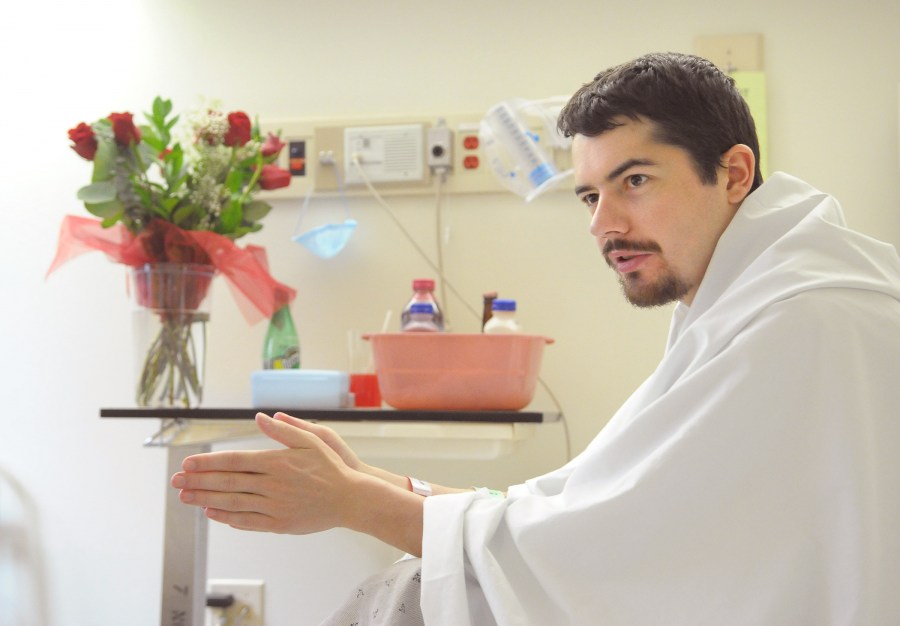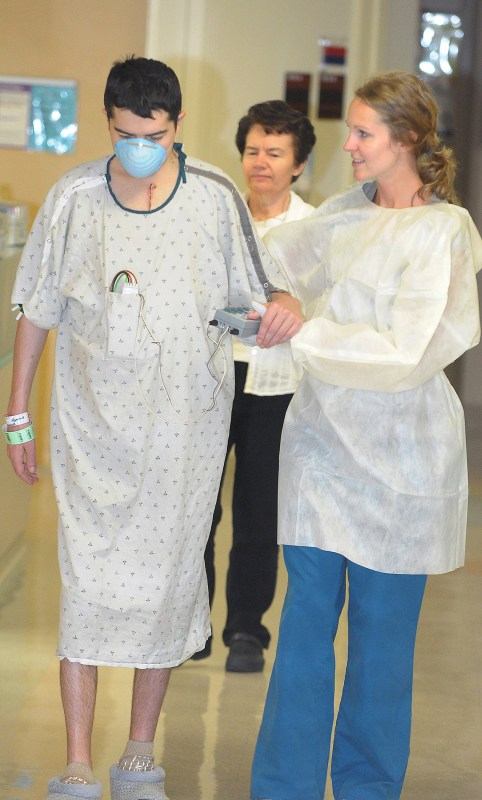
Yaroslav Zubkov, who grew up in Russia, is recovering at Vanderbilt following heart transplant surgery. (photo by Mary Donaldson)
Heart transplant patient’s long journey leads him to VUMC
Yaroslav Zubkov, 29, grew up in Russia with nary a health problem, never taking so much as a Tylenol. It is understandable that he and his family are still in shock to find themselves at Vanderbilt University Hospital, where Zubkov is recovering from heart transplant surgery.
How he went from being an avid runner and full-time accountant to heart transplant recipient in just a few months is the result of what Zubkov calls “bad luck.”
In 2009, after working a full day at his job in Chattanooga, Tenn., Zubkov, who has lived in the United States for 11 years, went home to his apartment and, without warning, suffered a stroke.
“All of a sudden I felt weakness on one side, and it started growing up my body. It happened during the night. I had to use the other half of my body to crawl to the sofa to call for help,” he said.
He was admitted to a hospital in Chattanooga where doctors discovered he had a bicuspid aortic valve, a valve that only has two leaflets instead of three. He was born with the anomaly, but never knew it existed. This particular congenital heart defect appears in about 3 percent of the general population and usually goes undetected until age 65 or older.
Zubkov's aortic and mitral valves had become infected, a condition called endocarditis, and doctors suspect some of the dead tissue sloughed off and traveled to his brain, causing the stroke. He underwent surgery to replace his diseased valves with mechanical ones on Aug. 13, 2009.
“Thirteen is my lucky number,” he said. But not all luck is good luck.
Zubkov developed an allergic reaction to heparin, the blood thinner most commonly given to cardiac surgery patients. He developed necrosis in his feet due to lack of blood supply and had to have part of both feet amputated. He jokes that he has 10 fingers and three toes — for a total of 13 digits. Only someone with Zubkov's disposition could find the humor in that.

Heart patient Yaroslav Zubkov walks with physical therapist Tara La Fevor, right, and his mother, Maria Zubkov. (photo by Mary Donaldson)
Zubkov didn't recover well from his surgery, and struggled to overcome septic shock and multiple organ failure.
“The surgeon came out and told me he wasn't sure he'd make it from the operating room to the ICU,” recalls his mother, Maria, who is a nurse.
She brought her son to Vanderbilt in hopes of saving his life. The cardiac transplant team met to discuss his case. Among other things, they were concerned that the wounds on his feet were not healing well, which put him at risk for infection. He would have to undergo plastic surgery and skin grafts to repair them before he could be considered for a transplant.
“We knew he'd be a high-risk case,” said Rashid Ahmad, M.D., assistant professor of Cardiac Surgery. “We knew that surgically he would be a technical challenge. His previous surgery was only a few months earlier, so getting into his chest to his heart would be dangerous. He was so young, which was a huge plus. Given those barriers, we felt we had to do everything we could to safely transplant him.”
In March he was placed on a waiting list for a heart. Meanwhile, an intra-aortic balloon pump provided circulatory support while he waited for one to become available.
“His chances of survival without a transplant were less than 10 percent,” said his cardiologist, Mark Wigger, M.D., assistant professor of Medicine and director of Transplant Cardiology, who, along with Tom DiSalvo, M.D., associate professor of Medicine, cared for Zubkov before and after his transplant.
On June 13, he got the call that a new heart had been located. In an eight-hour operation, Ahmad and Steven Hoff, M.D., assistant professor of Cardiac Surgery, removed his damaged heart and put the new one in place. He has done remarkably well and was moved from the cardiovascular intensive care unit to the step down unit, room 7013 — a sign that his luck was about to change.
“His prognosis is good,” Wigger said, adding that Zubkov was the beneficiary of close collaboration among cardiologists, surgeons, nurses, social services and physical therapy, all of whom contributed to his positive outcome.













